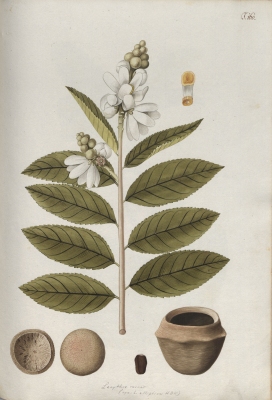Lecythis minor
Jacq.
Lecythidaceae
Chyrtoma valida Miers
Eschweilera valida (Miers) Niedenzu
Lecythis bipartita Pittier
Lecythis elliptica Kunth
Common Name:
General Information
Lecythis minor is a tree.
The edible seeds are gathered in quantity for local use[
]. The tree is also cultivated for this seed within its native range, and also in Panama and Cuba[
]. It shows good potential for further development as a commercial crop[
335- Title
- Perennial Edible Fruits of the Tropics : an Inventory
- Publication
-
- Author
- Martin, F. W.; Campbell, C. W.; Rubertbe, R. M.
- Publisher
- U.S. Dept. of Agriculture, Agricultural Research Service
- Year
- 1987
- ISBN
-
- Description
- A booklet giving terse details of almost 300 species of edible fruits, plus regional lists of Botanical and Common names for over 2,500 less well-known edible fruits of the tropics.
].
Known Hazards
In some areas the seeds are reported to be somewhat toxic. The toxicity may depend on selenium concentration in the soil[
]. Selenium poisoning can cause temporary loss of hair and nails and nausea.
Botanical References
Range
Northwestern S. America - Colombia, Venezuela.
Habitat
Not known
Properties
| Edibility Rating |      |
| Habit | Tree |
| Height | 0.00 m |
| Cultivation Status | Cultivated, Wild |
Cultivation Details
A plant of the hot, humid, tropical lowlands[
335- Title
- Perennial Edible Fruits of the Tropics : an Inventory
- Publication
-
- Author
- Martin, F. W.; Campbell, C. W.; Rubertbe, R. M.
- Publisher
- U.S. Dept. of Agriculture, Agricultural Research Service
- Year
- 1987
- ISBN
-
- Description
- A booklet giving terse details of almost 300 species of edible fruits, plus regional lists of Botanical and Common names for over 2,500 less well-known edible fruits of the tropics.
].
Prefers a deep, fertile soil[
335- Title
- Perennial Edible Fruits of the Tropics : an Inventory
- Publication
-
- Author
- Martin, F. W.; Campbell, C. W.; Rubertbe, R. M.
- Publisher
- U.S. Dept. of Agriculture, Agricultural Research Service
- Year
- 1987
- ISBN
-
- Description
- A booklet giving terse details of almost 300 species of edible fruits, plus regional lists of Botanical and Common names for over 2,500 less well-known edible fruits of the tropics.
].
Edible Uses
Seed - raw or roasted[
335- Title
- Perennial Edible Fruits of the Tropics : an Inventory
- Publication
-
- Author
- Martin, F. W.; Campbell, C. W.; Rubertbe, R. M.
- Publisher
- U.S. Dept. of Agriculture, Agricultural Research Service
- Year
- 1987
- ISBN
-
- Description
- A booklet giving terse details of almost 300 species of edible fruits, plus regional lists of Botanical and Common names for over 2,500 less well-known edible fruits of the tropics.
]. An excellent flavour[
335- Title
- Perennial Edible Fruits of the Tropics : an Inventory
- Publication
-
- Author
- Martin, F. W.; Campbell, C. W.; Rubertbe, R. M.
- Publisher
- U.S. Dept. of Agriculture, Agricultural Research Service
- Year
- 1987
- ISBN
-
- Description
- A booklet giving terse details of almost 300 species of edible fruits, plus regional lists of Botanical and Common names for over 2,500 less well-known edible fruits of the tropics.
]. The seed is rich in oil, protein and B vitamins[
335- Title
- Perennial Edible Fruits of the Tropics : an Inventory
- Publication
-
- Author
- Martin, F. W.; Campbell, C. W.; Rubertbe, R. M.
- Publisher
- U.S. Dept. of Agriculture, Agricultural Research Service
- Year
- 1987
- ISBN
-
- Description
- A booklet giving terse details of almost 300 species of edible fruits, plus regional lists of Botanical and Common names for over 2,500 less well-known edible fruits of the tropics.
].
Medicinal
None known
Other Uses
We have no specific information on the wood of this species. A general description of the wood from this genus is as follows:-
The heartwood is light to dark salmon; the sapwood is creamy-yellow. The texture is medium fine and uniform; the grain fairly straight or slightly interlocked; lustre is mostly low but high in some species; there is no distinctive odour or taste. The wood is reported to be very durable upon exposure to both a white-rot and a brown-rot fungus confirming its reputation for high resistance to decay; it is also highly resistant to dry-wood termites and is reported to be moderately resistant to marine borer attack. It is rated as easy to moderately difficult to air season, depending on species; a slow to rapid drying rate is reported; warp and checking ranged from slight to moderate. The wood is moderately difficult to work because of its high density; however, surfaces obtained in planing, boring, sawing, and shaping were smooth and rated as good to excellent. Silica content varies with species and dulling of cutters is also variable. The wood is used for purposes such as heavy construction, ship keels and beams, railroad crossties, industrial flooring and other uses requiring high impact resistance (wagon wheels, tool handles), turnery[
316- Title
- Tropical Timbers of the World. Ag. Handbook No. 607.
- Publication
-
- Author
- Chudnoff. Martin.
- Publisher
- USDA Forest Service. Wisconsin.
- Year
- 1984
- ISBN
-
- Description
- Terse details on the properties of the wood of almost 400 species of trees from the Tropics.
].
Propagation
Seed -
If you have any useful information about this plant, please leave a comment. Comments have to be approved before they are shown here.








 Useful Tropical Plants Database 2014 by
Ken Fern,
web interface by
Ajna Fern
with help from
Richard Morris.
Useful Tropical Plants Database 2014 by
Ken Fern,
web interface by
Ajna Fern
with help from
Richard Morris.